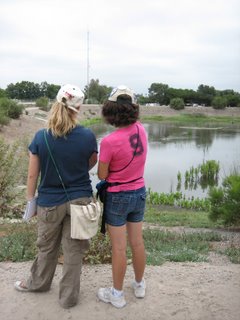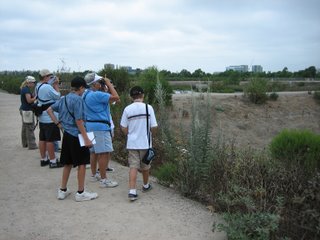The kids are all right
The four teenage girls set out ahead of me and their leader, Grace. As part of the Advanced Birding Camp offered by Sea & Sage Audubon Society, we planned to walk around the ponds at San Joaquin Wildlife Sanctuary in Irvine, Calif.
 The overcast morning offered a nice setting for the daily bird walk. At Pond E, the girls quickly called out Great Blue Heron (standing on one leg atop a telephone pole), Mourning Dove, Great Egret, Black-necked Stilt, American Avocet.
The overcast morning offered a nice setting for the daily bird walk. At Pond E, the girls quickly called out Great Blue Heron (standing on one leg atop a telephone pole), Mourning Dove, Great Egret, Black-necked Stilt, American Avocet.
Then, the campers began trying to I.D. three unfamiliar, similar birds among the Mallards on one bank. Grace and the teenagers started calling out the field marks while looking through their binoculars and a spotting scope: "I see a definite white eye-ring... The legs look yellow... The bill seems to be straight... Its feathers are all speckled."
More campers arrived, holding their notebooks and pencils and field guides, and opinions started filling the air: Great Knot, Pectoral Sandpiper, some kind of yellowlegs. A walkie-talkie allowed the leaders to summon another adult birder to offer a definitive opinion. She soon looked through the scope and named it a juvenile Greater Yellowlegs. Puzzle solved. Now, on to find another one.

At the next body of water, Pond D, we saw a baby Black-necked Stilt and a Killdeer feeding on the mudflats and watched Wilson's Phalaropes spinning in the water. Adult and immature Forster's Terns surrounded a group of Long-billed Dowitchers, and Snowy Egrets added some height to the crowd.
At Pond C, the Least Terns busily hunted for fish and constantly called, just as the teenagers constantly chattered about this or that bird. A Ruddy Duck swam on the west side near the reeds, near the juvenile Black-crowned Night-Heron.
An adult birder alerted Grace to a unique bird near the back of Pond C. The teens walked north toward the dogleg and peered at the ducks. There -- by the white pole -- a duck with a red head swam in alternating directions.
 Was it a Redhead? Check the color of the bill and the color of the eye. What about the slope of forehead? Was it a Canvasback? Opinions hovered above the group as the teens again looked in their field guides and peered through their binoculars and the scope. Final verdict: Canvasback, due to the shape of its head and the red eye.
Was it a Redhead? Check the color of the bill and the color of the eye. What about the slope of forehead? Was it a Canvasback? Opinions hovered above the group as the teens again looked in their field guides and peered through their binoculars and the scope. Final verdict: Canvasback, due to the shape of its head and the red eye.
A Pied-billed Grebe swam by itself in the dogleg, and an Eared Grebe briefly showed off its red eye before submarining again. Turning to the east side of the path, facing Pond D, one of the girls spied a Semipalmated Plover through the scope and on the mudflat in the back.
And then came an excited squeal: Virginia Rail in the reeds! The delighted squeals increased in number and volume. Quick dances of joy erupted. The spotter received hugs and adoration. It was a Good Day for a bird walk.

 The overcast morning offered a nice setting for the daily bird walk. At Pond E, the girls quickly called out Great Blue Heron (standing on one leg atop a telephone pole), Mourning Dove, Great Egret, Black-necked Stilt, American Avocet.
The overcast morning offered a nice setting for the daily bird walk. At Pond E, the girls quickly called out Great Blue Heron (standing on one leg atop a telephone pole), Mourning Dove, Great Egret, Black-necked Stilt, American Avocet.Then, the campers began trying to I.D. three unfamiliar, similar birds among the Mallards on one bank. Grace and the teenagers started calling out the field marks while looking through their binoculars and a spotting scope: "I see a definite white eye-ring... The legs look yellow... The bill seems to be straight... Its feathers are all speckled."
More campers arrived, holding their notebooks and pencils and field guides, and opinions started filling the air: Great Knot, Pectoral Sandpiper, some kind of yellowlegs. A walkie-talkie allowed the leaders to summon another adult birder to offer a definitive opinion. She soon looked through the scope and named it a juvenile Greater Yellowlegs. Puzzle solved. Now, on to find another one.

At the next body of water, Pond D, we saw a baby Black-necked Stilt and a Killdeer feeding on the mudflats and watched Wilson's Phalaropes spinning in the water. Adult and immature Forster's Terns surrounded a group of Long-billed Dowitchers, and Snowy Egrets added some height to the crowd.
At Pond C, the Least Terns busily hunted for fish and constantly called, just as the teenagers constantly chattered about this or that bird. A Ruddy Duck swam on the west side near the reeds, near the juvenile Black-crowned Night-Heron.
An adult birder alerted Grace to a unique bird near the back of Pond C. The teens walked north toward the dogleg and peered at the ducks. There -- by the white pole -- a duck with a red head swam in alternating directions.
 Was it a Redhead? Check the color of the bill and the color of the eye. What about the slope of forehead? Was it a Canvasback? Opinions hovered above the group as the teens again looked in their field guides and peered through their binoculars and the scope. Final verdict: Canvasback, due to the shape of its head and the red eye.
Was it a Redhead? Check the color of the bill and the color of the eye. What about the slope of forehead? Was it a Canvasback? Opinions hovered above the group as the teens again looked in their field guides and peered through their binoculars and the scope. Final verdict: Canvasback, due to the shape of its head and the red eye.A Pied-billed Grebe swam by itself in the dogleg, and an Eared Grebe briefly showed off its red eye before submarining again. Turning to the east side of the path, facing Pond D, one of the girls spied a Semipalmated Plover through the scope and on the mudflat in the back.
And then came an excited squeal: Virginia Rail in the reeds! The delighted squeals increased in number and volume. Quick dances of joy erupted. The spotter received hugs and adoration. It was a Good Day for a bird walk.


3 Comments:
ah yes, Advanced Camp, always a blast. I wish I would have been free enough to work this week, damn summer school =)
Wow I think it took ten years to get those birds.
Leigh, I wondered why you weren't there (c:
Shawn, it's an amazing spot in the middle of suburban SoCal. Keep it in mind if you visit the area!
Post a Comment
<< Home